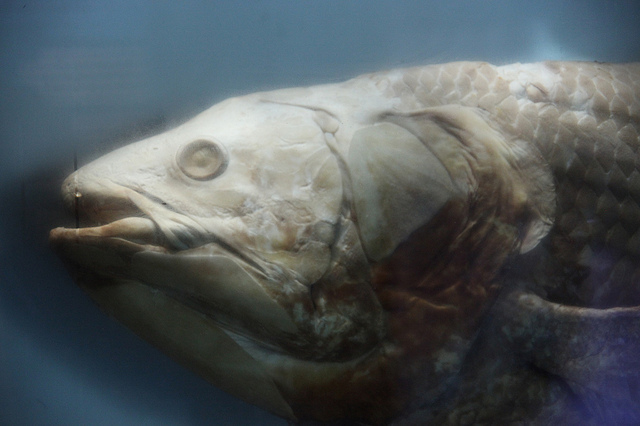
The coelacanth was discovered in 1938, but scientists already knew what the organism looked like. It's the lone representative of a lineage that we knew from fossils, the last of which were preserved while the dinosaurs still roamed the earth. Thus, the coelacanth earned the nickname of "living fossil," but that's a bit misleading. Although it looks similar, we have no real idea of how much or how little the organism has changed during those millions of years. After all, on the DNA level, the tuatara (the last representative of a lineage that originated in the Triassic) is the fastest evolving creature we know of.
Still, the coelacanth is interesting to scientists. It, along with the lungfish, is representative of a group called lobe-finned fishes, which have four limb-like fins. A series of fossils have revealed that these fins gradually transformed into the four limbs of modern tetrapods such as reptiles, birds, amphibians, and mammals. So, the coelacanth could tell us something about the base state that our limbs started out in. To find out, researchers have now sequenced its genome, and they found that genes essential to constructing our limbs were already active in the fins of the coelacanth.
The genome itself is just another example of all we can do with the massive DNA sequencing capacity that we've built up. Things only get interesting when you compare the coelacanth's genome to the genomes of other species. These tests do show that the coelacanth lives up to its dinosaur-era reputation, as its proteins are changing at the lowest rate of any vertebrate we've looked at. The new genome also makes it clear that the lungfish is more closely related to tetrapods than the coelacanth.
Tetrapods evolved some specialized genes to adapt to living on land, but the coelacanth genome shows that a number of genes controlling the development of fish-specific features have been lost. More than 50 genes shared by all fish are no longer present in tetrapods, many of them key developmental regulators (BMP, wnt, and FGF signaling networks are all affected). Among the organs that normally express the missing genes in fish are the ear, kidney, tail, and fin. This is about what you'd expect.
What can we tell about the transition of fins to limbs? Work in other organisms has demonstrated that a cluster of genes (called a Hox cluster, for the homeobox genes it encodes) is key to establishing the identity of all the bones that make up our limbs. The genes themselves are identical in almost all vertebrates (including the coelacanth), which suggests that the location and timing of their activity is key. And these factors are controlled by regulatory DNA sequences outside the ones that encode proteins.
Despite the hundreds of millions of years of time that separate us, the authors were able to compare the coelacanth genome with that of limbed vertebrates and pick out regulatory DNA near the Hox cluster. When placed into a mouse, the fish DNA was able to drive expression of genes in the areas of the limb normally seen in tetrapods. This means the genetic tools to make a complex limb were in place long before there was anything other than a fin being built. Tetrapods have since added a number of additional regulatory sequences in the region that probably refine the gene activity.
The coelacanth wasn't the only fish genome completed this week. In the same edition of Nature, researchers announced the completion of the zebrafish genome, a project that was started more than a decade ago. Although it's mostly found in home aquariums, the zebrafish has also made its way into genetics labs. Here, the zebrafish's small size and transparent embryo make it useful for studying development. As such, like mice and flies, its genome was an obvious target for sequencing.
Unfortunately, the project turned out to be much harder than expected. Part of problem was that the group the zebrafish belongs to, the teleosts, ended up with a duplication of its genome at some point in its evolutionary past. Most of the extra DNA has since been lost, but some of it has evolved new functions or specializations. This means many genes have extra copies relative to other vertebrates (with more than 26,000 genes, the fish has the most genes of any vertebrate we've looked at).
As if sorting all the extra genes out wasn't enough of a problem, the zebrafish also has the most repetitive DNA yet seen in a vertebrate. A lot of this is what's commonly called junk—dead viruses, mobile genetic parasites, and more. Since many of these genes are similar to each other, it can make figuring out where any particular DNA sequence is supposed to reside rather challenging.
Nevertheless, the team behind the project has persevered. A dozen years later, their work is done. Fish researchers everywhere are almost certainly relieved.
Nature, 2013. DOI: 10.1038/nature12027, 10.1038/nature12111 (About DOIs).
reader comments
35